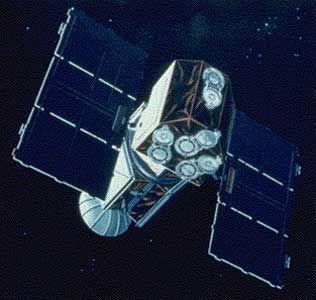
Home - Search - Browse - Alphabetic Index: 0- 1- 2- 3- 4- 5- 6- 7- 8- 9
A- B- C- D- E- F- G- H- I- J- K- L- M- N- O- P- Q- R- S- T- U- V- W- X- Y- Z
EUVE
 EUVE Credit: Manufacturer Image |
AKA: Extreme Ultraviolet Explorer. Status: Operational 1992. First Launch: 1992-06-07. Last Launch: 1992-06-07. Number: 1 . Gross mass: 3,275 kg (7,220 lb). Height: 4.50 m (14.70 ft).
The objectives of the EUVE Extreme Ultra-Violet Explorer mission were: (1) produce a high-sensitivity "all-sky" survey in the 70- to 760-angstrom portion of the spectrum; (2) perform a "deep survey" of a strip of the sky along the ecliptic with extremely high sensitivity; (3) perform follow-up spectroscopic observations on bright extreme ultraviolet point sources; (4) study stellar evolution and the local stellar population; (5) investigate energy transport in stellar atmospheres; and (6) study ionization and opacity of the interstellar medium. The initial "all-sky" survey was completed in January 1993, and a Guest Observer program was initiated in February 1993. EUVE was controlled from the Centre for EUV Astrophysics at the University of California, Berkeley. The spacecraft was based on the NASA/Fairchild Multi-Mission Spacecraft (MMS) bus and was 3-axis stabilized. Downlink was through TDRSS at 512 kbit/sec. EUVE was designed for on-orbit servicing by the Shuttle. The payload included three grazing incidence UV telescopes covering 80-900 angstroms (188 kg each) and one EUV spectrometer (323 kg). The scanning telescopes compiled all-sky maps over 80-900 angstroms with positional accuracy of 0.1 deg. The spectrometer observed in the anti-Sun direction along the ecliptic, to complete a survey in two bands between 80-500 angstroms.
NASA NSSDC Master Catalog Description
The Extreme-Ultraviolet Explorer (EUVE) was a spinning spacecraft designed to rotate about the earth/sun line. EUVE was a part of NASA's Explorer spacecraft series, and designed to operate in the extreme ultraviolet (EUV) range of the spectrum, from 70 - 760 Angstroms. This spacecraft's objective was to carry out a full-sky survey, and subsequently, a deep-survey and pointed observations. Science objectives included discovering and studying UV sources radiating in this spectral region, and analyzing effects of the interstellar medium on the radiation from these sources.
The full-sky survey was accomplished by three Wolter-Schwarzschild grazing-incidence telescopes. During the sky survey, the satellite was spun three times per orbit to image a 2 degree wide band of sky in each of four EUV passbands. The deep-survey was accomplished with a fourth Wolter-Schwarzschild grazing-incidence telescope, within a 2x180 degree region of sky. This telescope was also used for three-EUV bandpass spectroscopy of individual sources, providing ~ 1-2 Angstrom resolution spectra. The science instruments were attached to a Multi-mission Modular spacecraft (MMS). The MMS was 3-axis stabilized, with a stellar reference control system and solar arrays.
The EUVE mission was extended twice, but cost and scientific merit issues led NASA to a decision to terminate the mission in 2000. EUVE satellite operations ended on January 31, 2001 when the spacecraft was placed in a safehold. Transmitters were commanded off on February 2, 2001. EUVE re-entered the Earth's atmosphere over central Egypt at approximately 11:15pm EST on January 30, 2002. The mission is considered a success since it accomplished its scientific, technological, and outreach goals.
More at: EUVE.
Family: Astronomy, Medium earth orbit, Ultraviolet astronomy satellite. Country: USA. Launch Vehicles: Thor, Delta, Delta 2 6000, Delta 6920-10. Launch Sites: Cape Canaveral, Cape Canaveral LC17A. Agency: Fairchild, University of California. Bibliography: 2, 279, 6, 6489, 12369.
1992 June 7 - . 16:40 GMT - . Launch Site: Cape Canaveral. Launch Complex: Cape Canaveral LC17A. LV Family: Thor. Launch Vehicle: Delta 6920-10.
- EUVE - .
Mass: 3,275 kg (7,220 lb). Nation: USA.
Agency: NASA Greenbelt.
Class: Astronomy.
Type: X-ray astronomy satellite. Spacecraft Bus: MMS.
Spacecraft: EUVE.
Decay Date: 2002-01-31 . USAF Sat Cat: 21987 . COSPAR: 1992-031A. Apogee: 524 km (325 mi). Perigee: 510 km (310 mi). Inclination: 28.40 deg. Period: 95.00 min.
Extreme Ultra-Violet Explorer; mapped galactic EUV sources. The Extreme Ultraviolet Explorer was switched off on February 2, 2001. NASA decided to terminate funding for the mission, even though the spacecraft was still operating well. The sky survey was completed in January 1993 and after that the EUVE was used by guest astronomers for observations of specific targets. The final observations were made on January 26, 2001. After end-of-life tests of the never-used backup high voltage supplies and checking the remaining battery capacity, EUVE was stabilized pointing away from the Sun and sent into safehold at 2359 GMT on January 31. The transmitters were commanded off on February 2.
1993 January - .
- EUVE completes initial "all-sky" survey - . Nation: USA. Spacecraft Bus: MMS. Spacecraft: EUVE. A Guest Observer program was initiated in February, 1993..
Back to top of page
Home - Search - Browse - Alphabetic Index: 0- 1- 2- 3- 4- 5- 6- 7- 8- 9
A- B- C- D- E- F- G- H- I- J- K- L- M- N- O- P- Q- R- S- T- U- V- W- X- Y- Z
© 1997-2019 Mark Wade - Contact
© / Conditions for Use